
1870s Summer Fashions
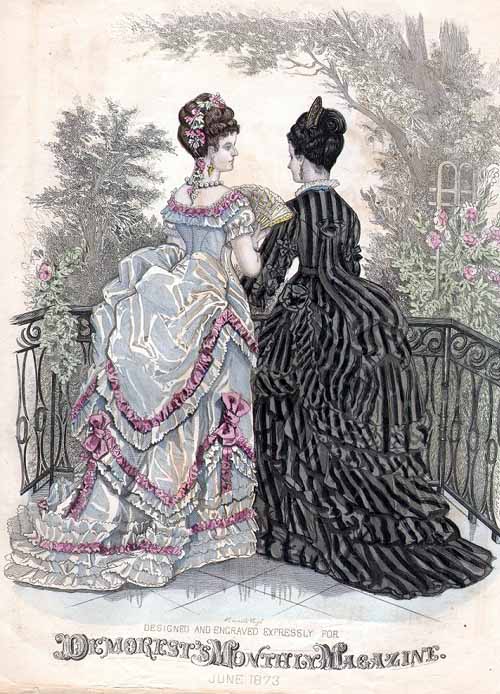
COLORED FASHION PLATE.
from Demorest’s, June, 1873
See full description below
|
This page contains a reprint of a fashion chit chat column, detailing Summer fashions,
from Demorest’s Illustrated Monthly Magazine, June 1873,
with some additional illustrations and descriptions from July 1873 and March 1874. The text on this page is predominately transcribed
from period sources. Any pattern numbers and prices are for research purposes only; these patterns are not available for purchase.
Table of Contents:
Related Pages:
|
SUMMER MATERIALS AND COSTUMES.
from Demorest’s Illustrated Monthly Magazine, June, 1873
(Note: All text illustrations are from June 1873 unless otherwise noted)
THERE has been much talk of changes in fashion and of the total disappearance of the pouf, the tournure,
the polonaise, and other distinctive parts of the modern costume. But it has ended, as such talk generally does end, in smoke.
No changes being perceptible in the general features of what have grown to be popular styles, and none likely to take place,
unless something is suggested more convenient and becoming than the basque, the overskirt, the polonaise, and the walking
skirt. The prominent spring fact is undoubtedly the redingote—literally, “great coat,” which has been made in cashmere,
camel's-hair cloth, serge, and sicillienne, with English turn-over collar, and cuffs of velvet, and mounted with oxydized
silver buttons. These redingotes, though simple, are very striking in appearance and not at all cheap, the material being
necessarily good and genuine, and the buttons, the only ornaments, very costly. They are worn principally with black silk skirts,
and divide the honors with walking costumes of black silk, and black wool, the latter of which embroidered, and trimmed with black
Yak lace, are greatly admired.
|
House Dress and Costume of Grenadine.

|
Fig. 1.(above left)—House dress of foulard finished percale a light-blue ground with polka
dots of dark-blue. The skirt is walking length—pattern No. 551—and encircled by three broad bands of plain dark-blue. The
overskirt—the “Lucette,” No. 1126—is trimmed to correspond. This is a particularly appropriate design for all washing
materials. The suit is completed by a plaited French waist, pattern No. 812, with the collar and cuffs of plain blue.
|
Fig. 2. (above right)—Costume of black grenadine, the
skirt of plain material, and the polonaise of grenadine with satin stripes, The skirt is a
demi-train, pattern No. 553, trimmed in front with perpendicular puffs, separated by narrow double ruffles, and the back
by five ruffles, placed straight around. Above these is a single ruffle arranged in points, which extend all around the
skirt. The polonaise—the “Celestine,” No. 1352—is trimmed with bias ruffles and fringe. The
arrangement of the back will be seen in the double illustration found elsewhere. A hat of dark-purple crépe,
and trimmed with lavender.
|
SUMMER MATERIALS AND COSTUMES. (continued)
For summer wear the redingote is made in linen, piqué, satin and Turkish toweling, all mounted with black velvet,
and trimmed with black velvet buttons, but this is objectionable on the score of washing, except to those ladies who can afford to
pass their soiled clothes over to their maids to be ripped, or otherwise taken care of.
Top
It is seldom that so great a variety of methods in making are fashionable as now—side pleatings, gathered flounces,
flounces to the knee, flounces covering the skirt, and, upon solid materials, plain bands. There is always something, however, which
serves as the distinguishing feature of an elegant costume; just now it is the sash.
|
Princess Dress.
A very dressy style of the favorite “Gabrielle,”
or “Princess” dress which is now so fashionable. The back
has a basque of a new cut, falling over a skirt with three puffs, and the front is cut in a plain Gabrielle style with the basque simulated
by the trimming. It is adapted to all goods excepting those very heavy or very thin. The trimming must be selected to correspond with the
goods. That illustrated is suitable for very dressy purposes; but a plainer style will be very effective.
|
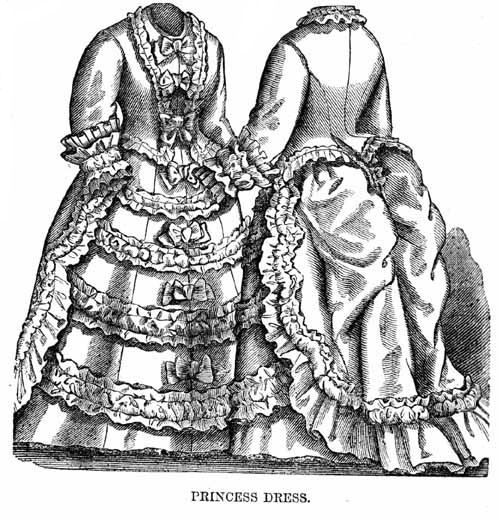
Top
|
Excepting in garments of this description, contrasts are not much affected in fashionable summer costumes. Unbleached
linens are embroidered in wools of deeper colors, such as maroons and browns, with excellent effect, but no violent contrasts are seen,
such as black braiding upon white, or scarlet upon écru, except in rare cases for children.
White upon dark blue is used, and dark blue upon unbleached linen and coutille. But these are rather exceptions to
a general rule, and are intended for exceptional purposes, seaside wear, and lake and mountain excursions.
For more dressy occasions light hair striped summer silks are among the most useful of toilettes, and are less expensive
even than grenadine, because, although they require a good deal of trimming and flouncing (like grenadine) to make them look well, yet they do
not require silk lining.
Marcia Overskirt.
It is useless to tell how it is arranged, except that it is disposed upon the side. The styles of arranging are as various
as the tastes of the wearers and the qualifications of the modiste. A pocket or satchel
of the silk (see illustration below), depending from two straps of silk, is
one of the latest ideas, but ordinarily the broad silk or velvet sash forms two loops and irregular ends
(see illustration to the right), which are used as effectively as
possible to aid in forming the drapery of the tournure.

from Demorest’s March, 1874.
Note the silk pocket satchel suspended
from the waist.
“This above design is very distingué in effect,
the apron being very long, perfectly plain, and carried very far back only sufficiently bouffant to be graceful
and becoming. The arrangement of the back is novel. it being cut straight across the bottom, and looped so as to form
the points. The design is adapted to most suit materials, and is especially pretty made
in silk, poplin, and cashmere. The trimming should be selected to correspond with the goods used. The bow in the back should be very
large. Pattern No. 1138, price thirty cents.”
|
Bianca Polonaise.
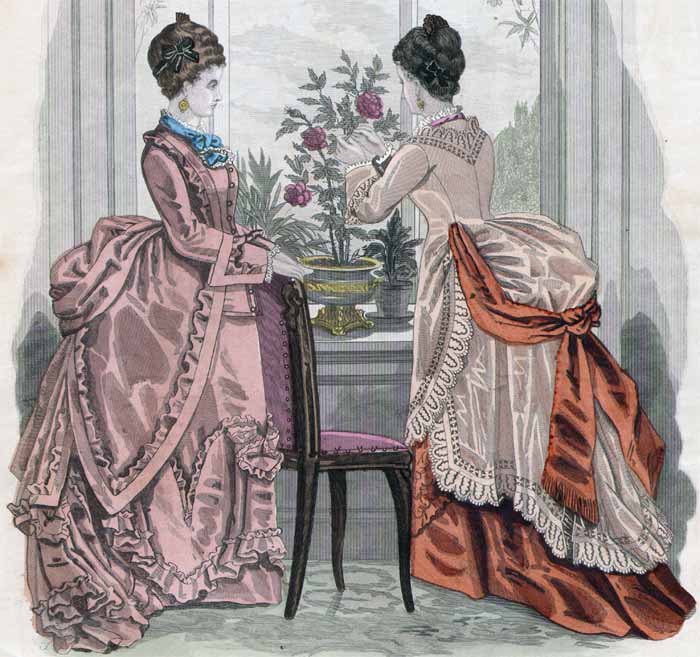
Color Plate from Demorest’s July, 1873.
Note the sash looped around the tournure drapery on the right.
DESCRIPTION OF COLORED STEEL PLATE.
FIG. 1.—A handsome toilet of ashes-of-roses
poult de soie, with the trimmings entirely of the material. The skirt, a demi-train,
pattern No. 553, is ornamented with a deep flounce, the exact arrangement of which can be fully understood by reference to the
separate illustration given elsewhere. The polonaise, the " Bianca," No. 1358, is especially stylish in effect, and very becoming.
The back view is shown on Fig. 2. Valenciennes lace frills at the neck and wrists. Peacock green necktie. High coiffure, ornamented
with a high Spanish comb and a bandeau of black velvet ribbon.
FIG. 2.—The polonaise on this toilette is of the same design as that on
Fig. 1—the “Bianca,” No. 1858—but made in batiste écru, trimmed
with Cluny lace and insertion of the same color. The sash is made of the same material as the skirt—brown silk. If it is not desired to
have the style of looping which is illustrated, the back of the polonaise may be looped in any other style. The skirt is a demi-train,
No. 553, the back without trimming, and the front ornamented with three broad puffs set on in deep points, so as to form a high trimming.
Deep frills of wash net at the neck and wrists. Rose-colored neck-tie.”
|
|
SUMMER MATERIALS AND COSTUMES. (continued)
Shot silks are coming into vogue again this season, and instead of being trimmed with white muslin flounces, distinguished
leaders of fashion are ornamenting them with flounces of black gauze, or grenadine, embroidered, or trimmed with laces. A tunic or apron of the
gauze is added to the upper part of the skirt, and the bodice is covered with a veste of the gauze, while the sleeves are of the silk, and only
show a ruffling of the gauze, lined with a plaiting of white tulle at the wrists. Bows of the silk ornament the veste and skirt.
For evening wear at the watering places, black gauze and black net dresses are being prepared, puffed lengthwise upon
the skirt, the bouillons widening toward the bottom. Wide sashes of thin black armure silk, embroidered in colors upon the ends, and deeply
fringed are worn with these toilettes, and the bodice and sleeves are trimmed with white Valenciennes lace, with the best effect.
Top
|
DESCRIPTION OF COLORED STEEL PLATE.
|
Evening Dress of White Tarletan.
FIG. 1.—Evening dress of white tarlatan, trimmed with ruchings and bows of rose-colored tarlatan. These
ruchings and flounces are all pinked on the edges, which makes them much lighter in effect. The skirt, a graceful train,
pattern No. 552, has the same style of trimming bordering it all the way round, and on the front upright ruchings alternately
of white rose-color. At the sides the trimming is carried up in the same design as that shown in the back, thus forming points
that correspond with those of the overskirt. This overskirt is the “Stuart” pattern No. 1123, and has a draped apron. Pointed
evening corsage, No. 817, with the neck cut square. High coiffure ornamented with trailing foliage, and small pink flowers.
Skirt pattern, in various sizes, thirty cents each. Overskirt pattern the same price. Waist pattern, in various
sizes, twenty cents each.
|
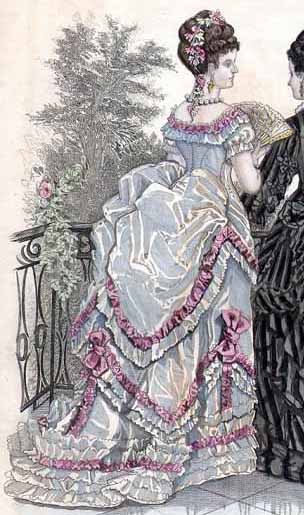
|
Toilette of Black Grenadine.
FIG. 2.—Toilette of black grenadine with a broad stripe. The skirt, a demi-train, pattern No. 552, is
ornamented with two deep bias flounces, each headed by a bias puff. These flounces are disposed in a semicircular shape both
in the back and front, the plain spaces at the sides at the bottom filled in with perpendicular puffs. The overskirt has broad
draped apron, and a Watteau plait is carried up in the back and fastened to the waist. This is trimmed around with a puff, and
is looped high at the sides. It is known as the “Watteau” overdress, pattern No. 1128.
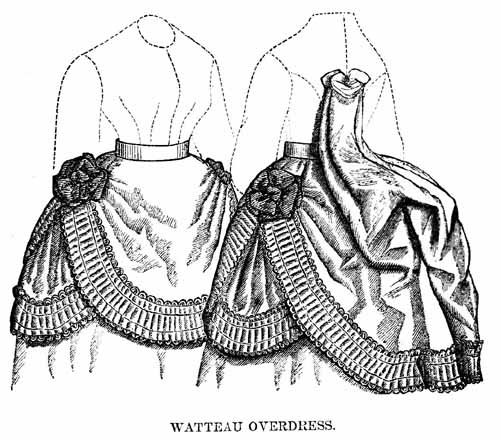
The waist is plain, pattern No, 813, and the sleeve, the “Aurelia,”
No. 767, forms three puffs in the back, and is especially appropriate
for this class of goods. High coiffure, ornamented with Spanish comb of tortoise-shell. Skirt pattern, in various sizes, thirty cents
each. Overskirt pattern, the same price. Waist pattern in various sizes, twenty cents each. Sleeve pattern ten cents.
|
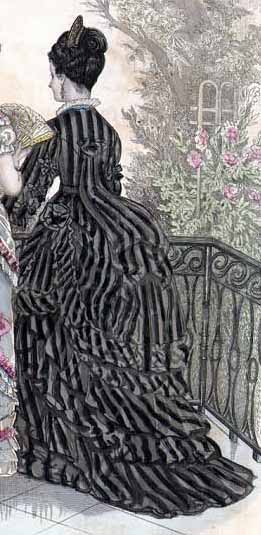
|
Top
|
SPRING AND SUMMER CLOAKS AND MANTLES.
The newest mantles of the season are a simple revival of the scarf mantelets of twenty years ago. Many of them are made
in the same way of alternate strips of plain or watered silk, and dotted lace, edged with a narrow gimp or passementerie. Others are made
of solid faille, high or low necked, with short square tabs, and with or without a pleating at the back which holds then in at the waist. The
trimming consists of fringe, lace, or a ruffle of the silk with a heading.
Later in the season lace mantelets will be introduced, fastened into the waist behind with sash bows, and ends of colored ribbon,
but these will hardly be as useful as the lace jackets, which are so very handsome this season, and cannot at all be put to the different
purposes of a lace shawl.
More simple, and much less expensive are the striped gauze, and grenadine scarfs, which in white, and black, can be worn
with almost any toilette, or the white muslin tunics, and scarf mantles, trimmed with lace, which divested of their ribbon garniture may,
in the hands of a skillful laundress, re-appear as good as new.
But undoubtedly in lace, the best investment is a white or black llama tunic or polonaise. These can be used upon almost
any occasion. For in, or out of doors, as a finish to a rather plain silk dinner toilette, as an addition to an opera or concert dress. There
is no end to the uses to which they can be put, nor to the service they are able to perform.
Top
|
PARASOLS.
THE new parasol, or sun-brella, is the “Union League Club.” It has a short, thick handle, mounted
in gilt, agate, knobs and crosses of ivory, oxidized silver, or shell, and is furnished with a chain to attach it to the
chatelaine. Blue and plum are the leading colors. These cost from $7 to $10.
Umbrellas in changeable Venetian silk, a soft twilled serge, in two shades, are very popular. Prices range from $7.50 to $18.00.
A very useful dressy style of parasol is in black silk lined with a color, or a color lined with white. These are large, have deep canopies,
and are bordered with double fringe in the two colors. Price $10. For visiting and church, small parasols are used, these are white, or a light
color, covered with lace, and are mounted on finely-carved sticks of yellow ivory, or fancy wood. These sticks alone cost from $6 to $20. Black
Llama lace covers cost from $3 upwards. Some real Chantilly are shown as low as $15. Thread lace costs from $22 upward.
|
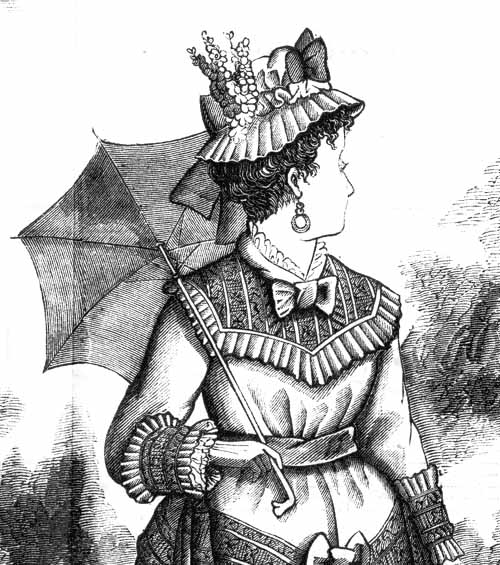
Costume of white Victoria lawn, trimmed with “Standard” fluting, bias tucking, and medallion trimming...
...Hat of white
swiss with a high, puffed crown, and the brim formed of “Standard” fluting. It is trimmed with pink azaleas, and light-green ribbon.
|
SCARF MANTELETS.
SCARVES and scarf mantelets have taken the place of capes to some extent, and are much more graceful, the cape is good for a
wrap, for negligee, for a finish to a waterproof, but it is not dress, though it be loaded down with trimming. The scarf mantelets are especially
pretty, and are made of silk, simply trimmed with ruffles of the same, or elegantly embroidered and trimmed with lace.
VEILS.
VEILS are square in shape, and grey or green are preferred colors.
The text and images on this page (unless otherwise noted)
are from Demorest’s Illustrated Monthly Magazine, June, 1873
|
|
|
|
|
>
|






last updated 13 july 2013/csb
|


